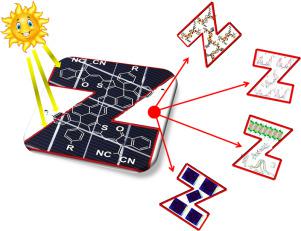Spectrochimica Acta Part A: Molecular and Biomolecular Spectroscopy ( IF 4.4 ) Pub Date : 2020-09-12 , DOI: 10.1016/j.saa.2020.118938 Muhammad Usman Khan , Riaz Hussain , Muhammad Yasir Mehboob , Muhammad Khalid , Muhammad Ali Ehsan , Abdul Rehman , Muhammad Ramzan Saeed Ashraf Janjua

|
Chrysene core containing fused ring acceptor materials have remarkable efficiency for high performance organic solar cells. Therefore, present study has been carried out with the aim to design chrysene based novel Z-shaped electron acceptor molecules (Z1-Z6) from famous Z-shaped photovoltaic material FCIC (R) for organic photovoltaic applications. End-capped engineering at two electron-accepting end groups 1,1-dicyanomethylene-3-indanone of FCIC is made with highly efficient end-capped acceptor moieties and impact of end-capped modifications on structure-property relationship, photovoltaic and electronic properties of newly designed molecules (Z1-Z6) has been studied in detail through DFT and TDDFT calculations. The efficiencies of the designed molecules are evaluated through energy gaps, exciton binding energy along with transition density matrix (TDM) analysis, reorganizational energy of electron and hole, absorption maxima and open circuit voltage of investigated molecules. The designed molecules exhibit red-shift and intense absorption in near-infrared region (683–749 nm) of UV–Vis-NIR absorption spectrum with narrowing of HOMO-LUMO energy gap from 2.31 eV in R to 1.95 in eV in Z5. Moreover, reduction in reorganization energy of electron from 0.0071 (R) to 0.0049 (Z5), and enhancement in open circuit voltage from 1.08 V in R to 1.20 V in Z5 are also observed. Twisted Z-shape of designed molecules prevents self-aggregation that facilitates miscibility of donor and acceptor. Low values of binding energy, excitation energy, and reorganizational energy (electron and hole) suggest that novel designed molecules offer high charge mobilities as compared to FCIC. Our findings indicate that these novel designed molecules can display better photovoltaic parameters and are suitable candidates if used in organic solar cells.
中文翻译:

高性能有机太阳能电池用Z形受体材料的第一个理论构架
含有稠环受体材料的ry核对于高性能有机太阳能电池具有显着的效率。因此,已经进行了本研究,目的是从用于有机光伏应用的著名的Z形光伏材料FCIC(R)中设计出基于丙烯的新型Z形电子受体分子(Z1-Z6)。FCIC的两个电子接受端基1,1-二氰基亚甲基-3-茚满酮的封端工程是通过高效封端的受体部分以及封端修饰对结构的性能关系,光伏和电子性质的影响而完成的新设计的分子(Z1-Z6)已通过DFT和TDDFT计算进行了详细研究。通过能隙,激子结合能以及跃迁密度矩阵(TDM)分析,电子和空穴的重组能,最大吸收和开路电压来评估设计分子的效率。设计的分子在UV-Vis-NIR吸收光谱的近红外区域(683–749 nm)中表现出红移和强烈吸收,并且HOMO-LUMO能隙从R中的2.31 eV缩小到Z5中的eV的1.95 。此外,电子的重组能从0.0071(R)降低至0.0049(Z5),开路电压从R的1.08 V提高至R的1.20V 。还观察到Z5。设计分子的扭曲Z形可防止自聚集,从而促进供体和受体的混溶性。结合能,激发能和重组能(电子和空穴)的值较低,表明与FCIC相比,新颖设计的分子具有较高的电荷迁移率。我们的发现表明,这些新颖设计的分子可以显示更好的光伏参数,并且如果用于有机太阳能电池中,则是合适的候选物。


























 京公网安备 11010802027423号
京公网安备 11010802027423号